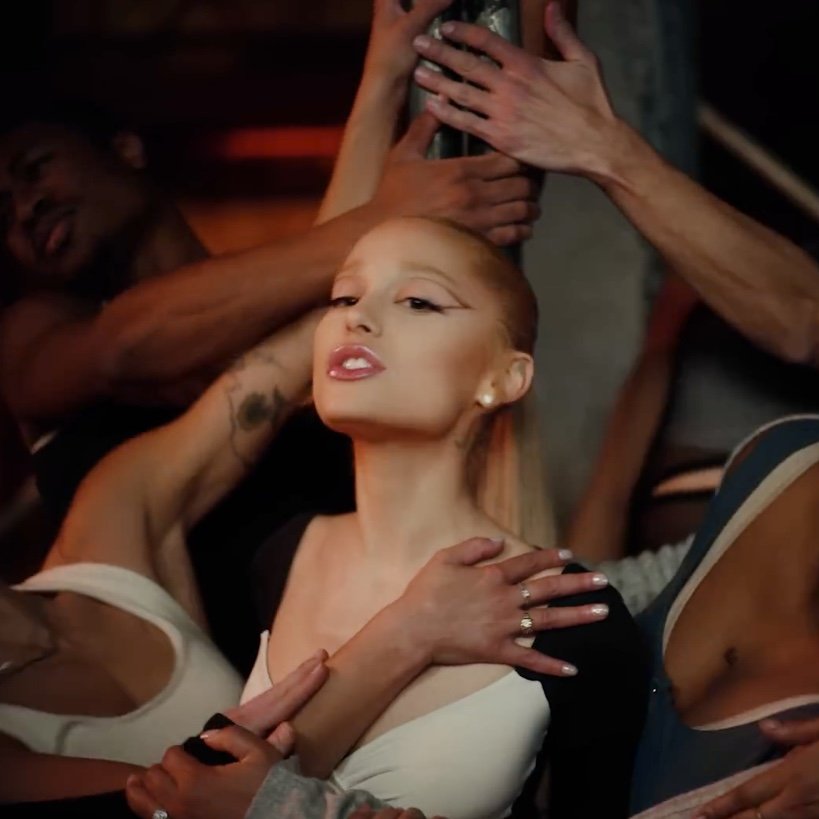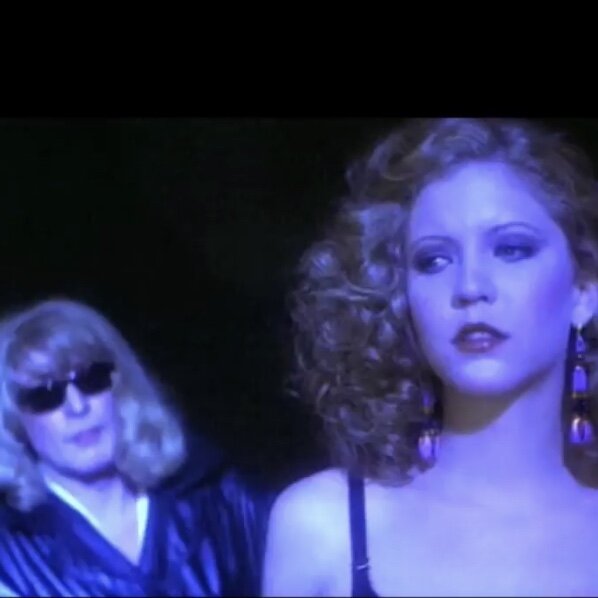From Fosse to Ari: The Origin of Ariana Grande’s “yes, and?” Video
As long as there have been artists, it’s pretty safe to say there have been critics. The relationship between the two is a complicated one, for it’s the artist who, in an act of vulnerability, steps into the arena (often literally) to present the creation, and with that, comes the (welcome or unwelcome, hopefully at least constructive) critique from the sideline.
An artist who recently commented about this relationship is Ariana Grande, via her latest music video for “yes, and?” from her seventh studio album, Eternal Sunshine, which saw the light of day on March 8. The track’s sound evokes classic piano and hi-hat ‘90s dance music, while the video treatment harkens back to a stylish ‘80s music video and even further back to an iconic ‘70s movie musical, so therefore, Ari’s video is an homage to an homage. Let’s put on our dancing shoes and retrace our steps:
One of the best depictions of this artist-critic exchange was featured in Bob Fosse’s 1979 semi-autobiographical musical-drama, All That Jazz. Broadway director and choreographer, Joe Gideon (Roy Scheider essentially portraying Bob Fosse) is burning the candle (and many cigarettes) at both ends, trying to cast and create a new show, plus complete the editing of a film, all while barely co-raising his young daughter, and popping a lot of pills.
The new show that Gideon is working on entitled, NY/LA, a loose reference to Fosse’s very own, Chicago, features a musical number about airline travel called “Take Off With Us” (a cheeky title already filled with foreshadowing). Gideon invites a few suit-wearing financial backers to preview the song and dance, which starts out with the character of a purser (Sandahl Bergman), along with her crew of dancing flight attendants, touting the exceptional service they will bestow up their passengers (“They only live to service you...”). The first half of the performance is bubbly, which garners smiles, even a round of applause midway through from the straight-laced observers, but unbeknownst to them, there’s a second half that suddenly turns steamy (literally), with one of the dancers welcoming all aboard “Airotica,” Gideon’s ode to the “Mile-High Club.”
The studio goes dim, now lit only via a few flashlights, with the dancers peeling off their clothes (the “take off with us” double entendre now realized), and pairing up to perform a sensual, then overtly sexual, albeit artistic, number, much to the confusion and disappointment of the backers, the realization sinking in about the limited monetary and sponsorship potential that the addition of “Airotica” will bring. “There goes the family audience,” the head backer whispers to his colleague. At the end, Gideon asks what they think, only for the head backer to feign acceptance and approval with a nervous smile.
Ten years later, the dancer and choreographer, Paula Abdul used Fosse’s “Take Off With Us” as the basis for her “Cold Hearted” music video, directed by a then relatively unknown, David Fincher. The video starts out with a group of record-company executives arriving at a rehearsal space, seemingly uninterested in what they’re there to preview. One says it’s a “Bob Fosse kind of thing; it’s gonna be really, really hot,” to which another executive nervously replies, “Yeah, but tastefully, it’s tastefully hot.”
The first two verses and choruses find Abdul and her crew dancing much to the toe-tapping approval of the executives, but by the bridge, a couple of the dancers begin lowering the window shades, thus beginning Abdul’s (understandably much tamer) version of “Airotica.”
A couple of the executives are turned off, a couple of them turned on. Similar to Gideon asking his backers, Abdul asks her audience, “Well, what do you think?,” to which a conservative executive reluctantly replies, “It’s very nice.”
In January 2024, Grande released “yes, and?” as a self-empowerment reminder amid a social-media culture of click-and-critique. The video came at a time when Grande, once again, became the subject of chatter surrounding her personal life, specifically her short-lived marriage, and quick subsequent kindling of a new relationship with a co-star from the film adaptation of Wicked. For the Christian Breslauer-directed video for “yes, and?,” which starts similarly to Abdul’s, a group of jaded critics reluctantly arrive at an industrial space, yet ironically can’t seem to talk about anything but Grande and her signature ponytail, with some of the critics even rehashing, and reacting to, internet-sourced gossip.
As these critics enter the space, an elated group exits. The new batch take their seats in front of a series of stone statues, one of which is in the form of Grande with her hands covering her eyes in a see-no-evil posture. As the song’s beat drops in, the statues crumble into piles of rubble. Grande is released to tell her story, with the bridge reserved for commentary to those who deliver just that about her (“Don’t comment on my body/do not reply/your business is yours/and mine is mine”).
Through confident lyrics and cohesive choreography, Grande and her dancers persuade the critics to drop their metaphorical stone exteriors as well. Yet just as this is achieved, she and her dancers within a flash assume their statuesque personas once again, perhaps symbolic of the thick shell needed to navigate the current, all-too-easy, drop-a-comment culture. As the newly elated converts leave, yet another cluster of critics enter, they too soon to be shook.
In summary, the common threads between the three depictions are as follows:
The critics arrive.
Principal female character with a group of dancers.
Principal character dressed in black, and wearing a black hat with brim.
Stripped-down, industrial-looking rehearsal space featuring scaffolding structures.
Principal character on top of the scaffolding structure.
The controlled critics sitting on chairs as the audience, as opposed to the creative artists “in the arena.”
There’s always a moment when the critics are enjoying what is presented to them.
The rehearsal space goes from light to dark for a version of “Airotica.”
When it comes to Ariana Grande’s “yes, and?” video, there’s no place like homage.
Photos 1, 8, 9, 10: Ariana Grande in the music video for “yes, and?,” directed by Christian Breslauer; Photos 2, 3, 4: All That Jazz, directed by Bob Fosse, cinematography by Giuseppe Rotunno; Photos 5, 6, 7: Paula Abdul in the music video for “Cold Hearted,” directed by David Fincher.
Double Trouble: Reflections on Brian De Palma’s Dressed to Kill
Brian De Palma’s Dressed to Kill is his (graphic) homage to Alfred Hitchcock’s 1960 classic, Psycho: Here’s a list of the some of the referential elements:
De Palma’s film incorporates not one, but two shower scenes;
Its female lead, Kate Miller (Angie Dickinson is to Janet Leigh’s Marion Crane; both characters essentially good women “gone bad”) is the “Hitchcock blond”;
Instead of a shower curtain, an elevator door is the temporary barrier that separates victim from killer, safety from harm, life from death;
Nancy Allen (is to Vera Miles) and Keith Gordon (is to John Gavin) step in as crime solvers;
Allen with a “tall blond” behind her and flickering lightning is to Miles with Anthony Perkins and a swinging lightbulb;
A psychiatrist (David Margulies to Simon Oakland) summarizes personality conflict, arousal and the human psyche.
Sunglasses At Night: Liz (Nancy Allen) and the “tall blond.”
Filmways Pictures. Cinematographer: Ralf D. Bode.
Also take note of duality as a running theme: Spoilers ahead: Besides De Palma’s signature split-screen technique, his script includes a scene where Michael Caine’s Dr. Elliott is on the phone in his office, taking the time to spell out his last name: “E; double l; i; o; double t,” plus there are a number of scenes involving mirrors: Elliot becoming startled when he catches his reflection in a mirror, with another occurrence shown in the trailer below; when Allen’s character, a call girl named Liz, seduces Elliott during a therapy session, he glances down to a mirror on his desk, and smirks devilishly. The audience also learns near the end of the film that there are two “tall blonds,” one with good intentions, the other, as already previously noted.
Although De Palma is certainly influenced by the Master of Suspense, he still manages to add his own visual stamps and a dreamy score by Pino Donaggio to create an enduring film that feels anything but a carbon copy.










